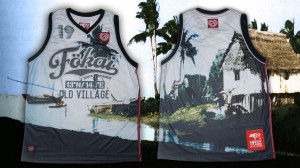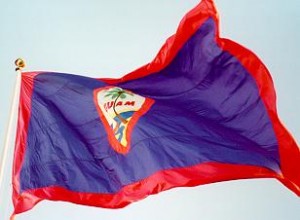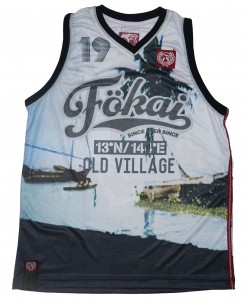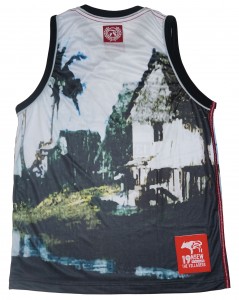
11 May ROOTS: Fokai OLD VILLAGE REAL FLAG TANK! Where the Guam Flag was designed.
ROOTS: Fokai OLD VILLAGE REAL FLAG TANK! Where the Guam Flag was designed.
Get your Fokai OLD VILLAGE REAL FLAG TANK here!
The Great Seal of Guam by: ns.gov.gu
The blueprint shows a tree and proa (canoe) in front of a silhouette of Urunao (It is not Two Lover’s Point, see below) and specifies the flag’s colors. There are several possible inspirations of the flag’s design, including a photograph from Gov. Robert E. Coontz’s collection from 1912, and the works of local artist Francisco Feja and Helen Paul, the wife of a U.S. Navy officer.
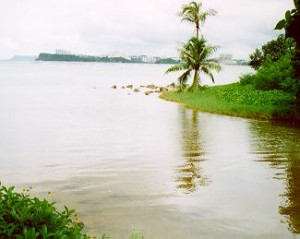 On July 4, 1917, Gov. Roy C. Smith approved the plan, and two days later, the flag was unveiled for the first time at a Hagåtña parade.
On July 4, 1917, Gov. Roy C. Smith approved the plan, and two days later, the flag was unveiled for the first time at a Hagåtña parade.
Taken from the center portion of the Guam Flag, Governor Roy C. Smith approved the design as the “Official Coat of Arms” for the territory of Guam on July 4, 1917. April 4, 1930 was the formal adoption date of the official Seal of the Territory of Guam, under the administration of Governor Willis W. Bradley Jr. who changed it from one with an eagle on it.
The Seal was designed in the city of Agana from a scene where the diverted Agana River formerly empties into the Philippine Sea in a spot to the left or south side of the Navy Yard Reservation. The ‘Landing’ at the end of the present day Hagatna Boat Basin Channel was where the Navy Yard used to be (from interview with Dr. Lawrence Cunningham). Following a disastrous typhoon which left only a coconut tree standing, this setting inspired the design for the official Seal of Guam. The shape of the Seal represents the shape of the slingstone which the ancient Chamoru warriors employ as an implement for defense. That iconic shape cradles and protects the rest of the features within the seal. At the heart of the seal is the coconut growing in the unfertile sand which depicts determination. Although partly uprooted during the recent typhoon, as if in utter defiance to all adversities, this tree with trunk partly bent, turned its open fronds to receive illumination from the heavens and continue its growth.
According to the Organic Act of Guam 1GCA, Chapter 4, Sections 410 and 411, “The Lieutenant Governor of Guam shall have custody of the Great Seal of the territory of Guam,” thus the Lieutenant Governor is the official “keeper” of the Seal.
DESCRIPTION OF THE FLAG’S SYMBOLS: The shape of the seal is that of a Chamorro sling stone used as a weapon for warfare and hunting. The sling stone was quarried from basalt and coral. The Coconut Tree, growing in unfertile sand, symbolizes self-sustanance and determination to grow and survive under any circumstance, with its fronds open to the sky — defies the elements to bend its will. Its bent trunk attests to a people which have been tested by famine, natural calamities, genocide and foreign wars but have continued to endure as a race. The Flying Proa, a seagoing craft built by the Chamorro people, which was fast and agile in the water required great skill to build and sail. The spanish marveled at the grace and speed of the proa which typifies the courage and freedom of the ancient Chamorros to fearlessly navigate and trade with islands thousands of miles from Guam. The original River channel (south side of present day Hagatna Boat Basin Channel), where fresh water rush out to interact with the ocean, symbolizes a willingness to share the resources of the land with others. The permanence of the land mass of Urunao (Ulu Enao) in the background (Rogers, Robert. Destiny’s Landfall. 1995 Univ of Hawaii Press. pg 142) demonstrates the Chamorro’s commitment to their homeland and environment, be it sea or land. The historian Pale Eric Forbes (http://paleric.blogspot.com)has written that the background of the seal is not Puntan Dos Amantes (aka Two lovers point, Cabo de Dos Amantes, Pt Desamante (from William Edwin Safford, Rev. Jose Palomo Y Torres, R.P. Tolman 1904 map)). Father Eric Forbes has stated that one cannot see Two Lover’s Point from Hagatna since Oka Peninsula (near Apurguan) blocks Hagatna’s view of the Two Lover’s Point. The background cliff juts majestically into the endless waters of the sea, protraying the people’s faithful commitment to passing their proud heritage, culture, and language to the endless sea of future generations. GUAM or GUAHAN means “we have” (see *notes below) is the home (“Tano Y Chamoru”) of the Chamoru people. A red stripe surrounding the Guam Seal representing the blood shed by its people during World War II and Spanish occupation. A field of Blue represents Guam’s unity with the sea and sky.


